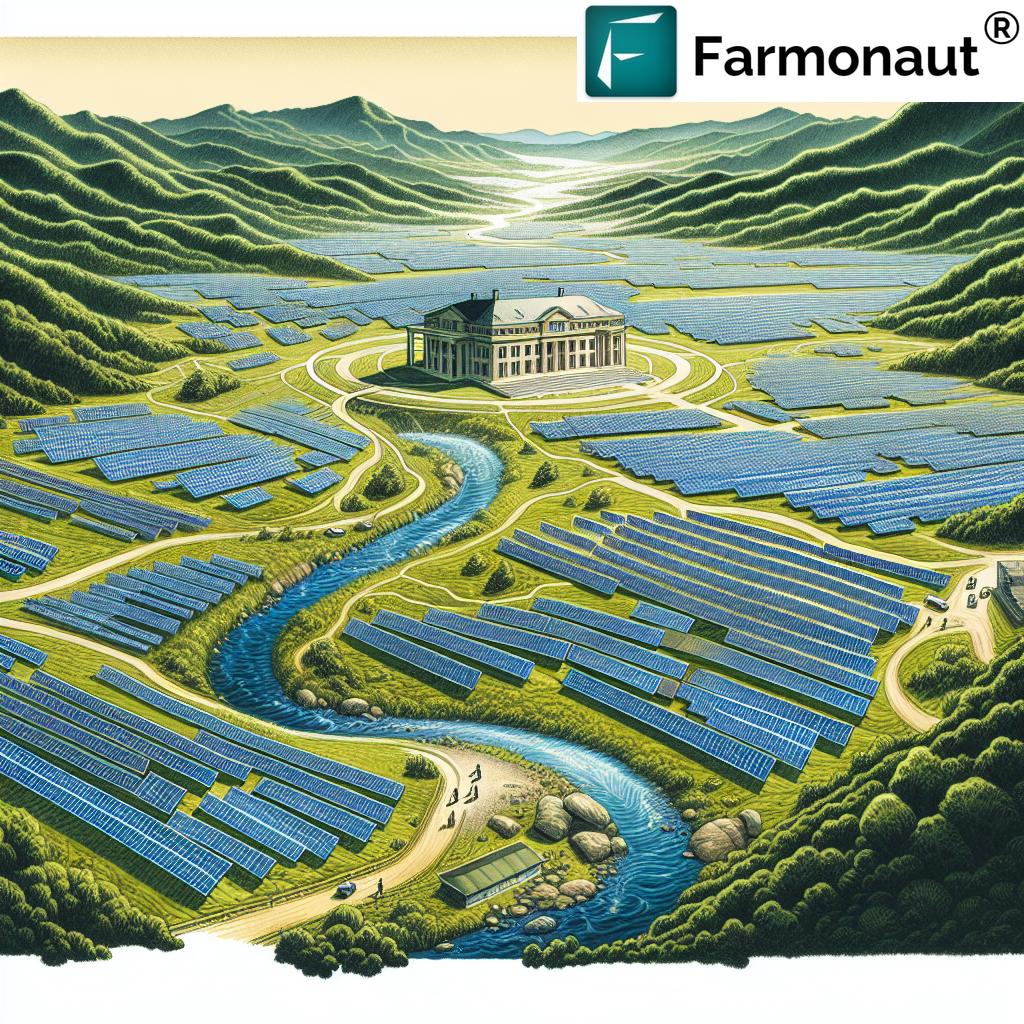Balancing Solar Energy and Environmental Conservation: New York’s Copake Project Sparks Debate

“The proposed Copake solar farm project in New York would generate 42 megawatts of renewable energy.”
In the picturesque town of Copake, New York, a contentious debate is unfolding that exemplifies the complex challenges faced by communities across the United States as they grapple with the urgent need for renewable energy and the equally pressing concern for environmental conservation. The proposed 42-megawatt Shepherd’s Run Solar Farm project has become a focal point of this discussion, highlighting the delicate balance between advancing clean energy goals and preserving local ecosystems and agricultural heritage.
As we delve into this multifaceted issue, we’ll explore the various perspectives, concerns, and potential benefits surrounding the Copake solar project. This case study offers valuable insights into the intricate process of implementing large-scale solar initiatives in rural areas, emphasizing the need for collaborative approaches that prioritize both sustainability and environmental stewardship.
The Copake Solar Project: An Overview
The Shepherd’s Run Solar Farm, proposed by Hecate Energy LLC, has been a topic of intense discussion since 2017. This 42-megawatt installation represents a significant step towards New York State’s ambitious clean energy targets. However, it has also raised concerns among local residents, environmental groups, and state legislators regarding its potential impacts on the local environment, water resources, and agricultural lands.
Key aspects of the project include:
- A 42-megawatt solar energy installation
- Located in the town of Copake, Columbia County, New York
- Potential impacts on the Taghkanic Creek watershed
- Concerns about wetland conservation and agricultural land use
The project’s journey through the permitting process has been tumultuous, with the state initially denying Hecate’s application in spring 2024. However, the company refiled in December, triggering a new 60-day review period that has reignited the debate and brought fresh scrutiny to the proposal.
The Debate: Renewable Energy vs. Environmental Conservation
At the heart of the Copake solar project controversy lies a fundamental question: How do we balance the urgent need for renewable energy with the equally important goal of environmental conservation? This dilemma is not unique to Copake but reflects a broader challenge faced by communities worldwide as they transition to cleaner energy sources.
Let’s examine the key arguments on both sides of this debate:
Arguments in Favor of the Solar Project
- Clean Energy Generation: The 42-megawatt capacity would significantly contribute to New York’s renewable energy goals.
- Climate Change Mitigation: Solar energy reduces reliance on fossil fuels, helping to combat global warming.
- Economic Benefits: The project could bring jobs and economic development to the area.
- Land Use Optimization: Solar farms can coexist with certain agricultural activities, such as sheep grazing.
Concerns Raised by Critics
- Water Resource Protection: Potential risks to the Taghkanic Creek watershed, which supplies 100% of Hudson’s water.
- Wetland Conservation: Fears of damage to local wetlands and their ecosystems.
- Agricultural Land Preservation: Concerns about the loss of prime farmland.
- Community Character: Worries about the visual impact on the rural landscape.
- Fire Safety: Proximity to schools and wildlife sanctuaries raises fire risk concerns.
As we navigate these complex issues, it’s crucial to consider innovative approaches that could help reconcile these seemingly opposing goals. For instance, Farmonaut’s satellite-based farm management solutions offer tools that could potentially assist in monitoring the environmental impact of solar installations while optimizing agricultural activities around them.
Stakeholder Perspectives
The Copake solar project has drawn attention from a wide range of stakeholders, each bringing unique perspectives to the table. Understanding these diverse viewpoints is crucial for developing a comprehensive understanding of the situation.
State Legislators
State Senator Michelle Hinchey and Assemblymember Didi Barrett have both expressed concerns about the project. Their objections focus on:
- Potential environmental risks, particularly to water supply
- Perceived lack of good faith engagement from Hecate Energy
- Failure to address community concerns adequately
Senator Hinchey, chair of the Agriculture Committee, questioned why the Office of Renewable Energy Siting (ORES) was still reviewing a proposal it had previously dismissed. This highlights the complex regulatory landscape surrounding renewable energy siting in New York.
Local Officials
Copake Town Supervisor Richard Wolf has been vocal in his criticism of Hecate’s approach, citing:
- Lack of meaningful engagement with the town and its residents
- Poor timing and format of community meetings
- Concerns about the project’s impact on local resources and character
The town’s leadership plays a crucial role in representing local interests and ensuring that any development aligns with community values and needs.
Environmental Groups
Organizations like Sensible Solar for Rural New York have raised alarms about potential environmental impacts, including:
- Wetland damage
- Risks to drinking water supply
- Fire hazards to nearby schools and wildlife sanctuaries
These groups emphasize the need for rigorous environmental assessments and safeguards before any project approval.
Supporters of the Project
Groups like Friends of Columbia Solar argue in favor of the project, citing:
- Urgent need for climate action
- Potential benefits to the town and wider community
- Importance of moving forward with renewable energy initiatives
Supporters view the project as a necessary step towards a sustainable future, emphasizing the broader context of climate change mitigation.

The Permit Process and Community Engagement
“The Copake solar project’s virtual open house process involved state legislators, local officials, and various community groups.”
The permitting process for the Shepherd’s Run Solar Farm has been marked by controversy and highlights the challenges of siting large-scale renewable energy projects. Key aspects of this process include:
- Initial application denial by the state in spring 2024
- Refiling of the application in December 2024
- 60-day review period for state response
- Virtual open house scheduled by Hecate Energy
The virtual open house, while an attempt at community engagement, has been criticized for its timing and format. This underscores the importance of meaningful and accessible community involvement in renewable energy siting decisions.
To better understand the complexities of land use and environmental monitoring in such projects, consider exploring Farmonaut’s satellite-based solutions, which offer valuable insights into land management and environmental impact assessment.
Environmental Concerns and Water Resource Protection
One of the most significant concerns raised about the Copake solar project is its potential impact on water resources, particularly the Taghkanic Creek watershed. This issue exemplifies the complex environmental considerations that must be addressed in renewable energy siting.
The Taghkanic Creek Watershed
The Taghkanic Creek is a critical water source, providing:
- 100% of the water supply for the city of Hudson
- Important ecological functions for local ecosystems
- Potential recreational and aesthetic value for the community
Concerns about the project’s impact on this vital resource have been raised by various stakeholders, including Hudson Mayor Kamal Johnson and the Hudson Common Council.
Wetland Conservation
The protection of wetlands is another crucial environmental concern. Wetlands play vital roles in:
- Water filtration and purification
- Flood control
- Habitat provision for diverse flora and fauna
Critics argue that the solar project could potentially damage or disrupt these sensitive ecosystems, impacting both water quality and local biodiversity.
Balancing Development and Conservation
The challenge lies in finding ways to develop renewable energy infrastructure while safeguarding critical natural resources. This may involve:
- Comprehensive environmental impact assessments
- Innovative project designs that minimize ecological disturbance
- Ongoing monitoring and adaptive management strategies
Technologies like those offered by Farmonaut could play a role in this balancing act, providing tools for precise land management and environmental monitoring.
Agricultural Land Use and Solar Energy
The Copake solar project raises important questions about the relationship between renewable energy development and agricultural land use. This issue is particularly significant in rural communities where farming plays a vital economic and cultural role.
Concerns About Agricultural Land Loss
Critics of the project worry about:
- Conversion of prime farmland to non-agricultural use
- Potential impacts on local food production
- Changes to the rural character of the community
Potential for Agrivoltaics
However, proponents argue that solar energy and agriculture can coexist through agrivoltaic systems, which involve:
- Dual use of land for both solar energy production and farming
- Potential benefits such as reduced water evaporation and shade for certain crops
- Opportunities for grazing animals like sheep among solar panels
Exploring these innovative approaches could help reconcile the need for renewable energy with the preservation of agricultural traditions.
Community Engagement and Project Modifications
The Copake solar project’s journey has been marked by ongoing discussions between Hecate Energy and the local community. These interactions have led to several modifications to the original proposal, demonstrating the importance of community input in shaping renewable energy projects.
Key Project Modifications
In response to community feedback, Hecate Energy has made several changes to the project plan, including:
- Excluding battery storage from the project scope
- Implementing native tree and shrub planting to minimize visual impact
- Extending and connecting local hiking trails
- Incorporating educational opportunities related to renewable energy
- Providing for sheep grazing within the solar farm area
These modifications highlight the potential for compromise and adaptation in renewable energy siting, addressing some community concerns while maintaining the project’s core objectives.
Ongoing Community Concerns
Despite these changes, some community members and officials remain skeptical. Persistent concerns include:
- Perceived lack of transparency in the planning process
- Questions about long-term environmental impacts
- Doubts about the effectiveness of proposed mitigation measures
Addressing these ongoing concerns will be crucial for building community trust and support for the project.
Regulatory Framework and Policy Implications
The Copake solar project exists within a complex regulatory environment that reflects broader policy goals and challenges in renewable energy development. Understanding this framework is essential for comprehending the project’s trajectory and its wider implications.
New York State’s Clean Energy Goals
The project aligns with New York’s ambitious clean energy targets, which include:
- 70% of electricity from renewable sources by 2030
- 100% zero-emission electricity by 2040
These goals create a strong impetus for large-scale renewable energy projects across the state.
Office of Renewable Energy Siting (ORES)
ORES plays a crucial role in the permitting process for renewable energy projects in New York. Its responsibilities include:
- Reviewing and approving applications for large-scale renewable energy facilities
- Balancing state energy goals with local concerns and environmental protection
- Ensuring compliance with relevant regulations and standards
The agency’s decisions have significant implications for projects like the Copake solar farm and set precedents for future renewable energy developments.
Local Zoning and Land Use Regulations
The interplay between state-level renewable energy goals and local land use regulations creates a complex landscape for project development. Key considerations include:
- Potential conflicts between state and local authorities
- The role of local zoning laws in shaping renewable energy siting
- Balancing community autonomy with broader energy policy objectives
Navigating these regulatory challenges requires careful consideration and often necessitates new approaches to policy-making and community engagement.
Lessons Learned and Future Considerations
The Copake solar project offers valuable insights for future renewable energy initiatives, highlighting the need for balanced approaches that address both environmental concerns and clean energy goals.
Key Takeaways
- Early and Meaningful Community Engagement: The importance of involving local stakeholders from the project’s inception cannot be overstated.
- Comprehensive Environmental Assessment: Thorough evaluation of potential impacts on water resources, wetlands, and local ecosystems is crucial.
- Innovative Land Use Solutions: Exploring options like agrivoltaics can help reconcile renewable energy development with agricultural preservation.
- Adaptive Project Design: Flexibility in project plans to accommodate community feedback and environmental concerns is essential.
- Transparent Communication: Clear, ongoing dialogue between developers, local officials, and community members builds trust and facilitates problem-solving.
Future Considerations for Renewable Energy Siting
As we move forward with renewable energy development, several factors will be crucial:
- Integrated Planning: Incorporating renewable energy goals into broader land use and environmental planning processes.
- Technology Advancements: Leveraging innovations in solar panel design and land management to minimize environmental impacts.
- Policy Evolution: Developing more nuanced policies that balance state-level clean energy targets with local environmental and community concerns.
- Collaborative Approaches: Fostering partnerships between developers, local communities, environmental groups, and agricultural stakeholders.
Tools like those offered by Farmonaut can play a crucial role in this evolving landscape, providing data-driven insights for land management and environmental monitoring in the context of renewable energy development.
Copake Solar Project: Pros and Cons Analysis
| Potential Benefits | Potential Concerns |
|---|---|
| Renewable Energy Generation (estimated 42 MW) | Impact on Taghkanic Creek Watershed |
| Climate Change Mitigation | Agricultural Land Use Changes |
| Economic Development | Community Landscape Alterations |
| Potential for Agrivoltaic Synergies | Wetland Conservation Risks |
| Contribution to State Clean Energy Goals | Local Community Division |
Conclusion
The Copake solar project serves as a microcosm of the broader challenges facing renewable energy development in rural communities. It highlights the delicate balance between advancing clean energy goals and preserving local environments and ways of life. As we continue to grapple with the urgent need for climate action, projects like this will play a crucial role in shaping our approach to sustainable development.
The lessons learned from Copake emphasize the importance of inclusive, transparent, and adaptive approaches to renewable energy siting. By fostering genuine dialogue, leveraging innovative technologies, and developing flexible policies, we can work towards solutions that meet our energy needs while respecting local ecosystems and community values.
As we move forward, it’s clear that the path to a sustainable future will require ongoing collaboration, creativity, and compromise. The Copake solar project, regardless of its ultimate outcome, offers valuable insights that can inform and improve future renewable energy initiatives across the country and beyond.
For those interested in exploring innovative solutions for land management and environmental monitoring in the context of renewable energy development, Farmonaut’s satellite-based farm management solutions offer cutting-edge tools that can provide valuable insights and support data-driven decision-making.
FAQ Section
1. What is the capacity of the proposed Copake solar project?
The proposed Shepherd’s Run Solar Farm project has a planned capacity of 42 megawatts.
2. What are the main environmental concerns associated with the project?
The primary environmental concerns include potential impacts on the Taghkanic Creek watershed, wetland conservation, and changes to agricultural land use.
3. How has the local community been involved in the project planning?
The community has been involved through public comments, virtual open houses, and engagement with local officials. However, some stakeholders have criticized the level and quality of this engagement.
4. What modifications has Hecate Energy made to the project in response to community feedback?
Modifications include excluding battery storage, implementing native plant screening, extending hiking trails, and providing for sheep grazing within the solar farm area.
5. How does this project align with New York State’s clean energy goals?
The project contributes to New York’s goal of achieving 70% renewable electricity by 2030 and 100% zero-emission electricity by 2040.
Resources for Further Information
For those interested in learning more about renewable energy siting, environmental conservation, and innovative agricultural technologies, we recommend the following resources:
- Farmonaut’s Satellite-Based Farm Management Solutions
- Farmonaut API for Developers
- Farmonaut API Developer Documentation
Earn With Farmonaut: Affiliate Program
Earn 20% recurring commission with Farmonaut’s affiliate program by sharing your promo code and helping farmers save 10%. Onboard 10 Elite farmers monthly to earn a minimum of $148,000 annually—start now and grow your income!






